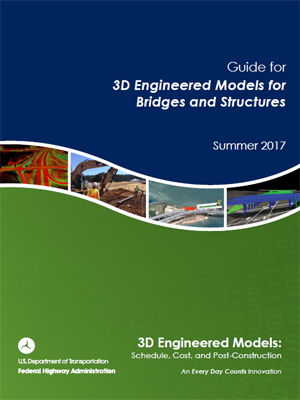Guidance

Guide for 3D Engineered Models for Bridges and Structures (Summer 2017) While much of the adoption of three-dimensional (3D) modeling for highways has been driven by cost savings, efficiencies, and lower risk in construction, routine inspection and asset management requirements for bridges make cross-functional uses a primary consideration for 3D models for structures. With so many bridges across the country needing rehabilitation or replacement, creating significant impacts to motorists who use them daily, visualization and construction simulation (also known as 4D or 5D modeling) helps transportation agencies engage with the public and plan work activities in narrow rights-of-way.
Guide for Determining the Return on Investment for using 3D Engineered Models in Highway Construction (Summer 2017) A return on investment (ROI) process provides decision makers with a transparent, data-driven decision support tool that guides investments in the most urgent and most valuable initiatives that generate the quickest positive return. This guide provides an ROI process that State Transportation Agencies (STAs) can use to assess implementing 3D engineered models in their project delivery process. Further, this guide discusses how to accelerate benefit capture through deliberate organizational improvements.
3D Modeling to Advance Utility Coordination in Projects Delivered Using Alternative Contracting Methods (May, 2017) Effective utility coordination in projects delivered using alternative contracting methods (ACM) has one common theme: utility issues must be considered as early in the project development process as possible to permit the project delivery team as many options for resolving utility conflicts as practical.
Guide for Optimizing Survey Data for 3D Design (March, 2017) This document provides general guidance intended to allow organizations to take a risk-based approach to investing in preconstruction survey. Understanding the risks and mitigation measures will allow STAs to better control the project costs and quality before construction begins.
Guide for Using 3D Engineered Models for Construction Engineering and Inspection (January, 2017) This guide highlights key considerations for deploying three-dimensional (3D) engineered models for construction inspection. These include generating workflows for activities before, during, and after construction through partnering agreements; updating or creating new specifications and workflows for inspection work; and providing the necessary training and tools for construction staff to be successful.
Guide for Creating and Maintaining 4D Models (October, 2016) This Guide presents the process of creating and updating the 4D model from the development of the schedule and 3D model, including details on software applications and work breakdown structure requirements to the workflow for creating the 4D model.
Guide for Efficient and Effective Utility Asset Data Collection Using Geospatial 3D Techniques (June, 2016) Geospatial, three-dimensional (3D), as-found utility survey technologies are key to achieving this asset management vision. These surveys integrate existing legacy utility data with new utility asset data collected with a variety of new survey technologies. When specified, integrated, and used correctly, 3D utility data can result in efficient workflows for agencies.
Guide for Selecting Projects Suitable for 4D Modeling (Summer 2016) This guide offers STAs new insights to managing project risk, optimizing resources, communicating with the public, and account transparently for construction expenditures by combining a 3D model with a project schedule to create a simulation of construction activities that represents the 4D model.
Guide for Efficient Geospatial Data Acquisition using LiDAR Surveying (March, 2016) This guide explores how state transportation agencies (STA) are now implementing new, innovative processes and technology for managing roadway assets. This guide draws attention to the key issues that a STA must address for the optimization of data collection for use in an enterprise digital data solution. These include developing information requirements for data collection and products to be delivered for specific purposes and disciplines within the agency, and implementing the data collection program itself.

